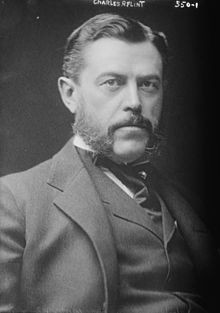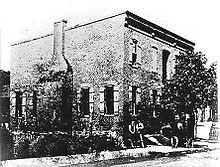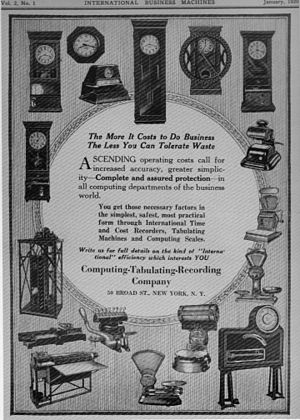- Computing Tabulating Recording Corporation
-
Computing Tabulating Recording Corporation 
Fate Renamed Successor IBM Founded 1911 Defunct 1924 Headquarters Endicott, New York, U.S. Key people Herman Hollerith (Founder)
Thomas J. Watson Sr. (President)The Computing Tabulating Recording Corporation (CTR)[1] was incorporated on June 16, 1911 in Endicott, New York a few miles west of Binghamton. CTR was formed through a merger of four separate corporations: Tabulating Machine Company (founded 1896 in Washington, D.C.), the Computing Scale Corporation (founded in 1891 in Dayton, Ohio), the International Time Recording Company (founded 1900 in Endicott, New York) and the Bundy Manufacturing Company (founded in 1889).[2][3] The companies that merged to form CTR manufactured a wide range of products, including employee time-keeping systems, weighing scales, automatic meat slicers and, most importantly for the development of computers, punched card equipment.
Contents
Tabulating Machine Company
Of the companies merged to form CTR, the most technologically significant was the Tabulating Machine Company, founded by Herman Hollerith, and specialized in the development of punched card data processing equipment. Hollerith's series of patents on tabulating machine technology, first applied for in 1884, drew on his work at the U.S. Census Bureau from 1879–82. Hollerith was initially trying to reduce the time and complexity needed to tabulate the 1890 Census. His development of punched cards in 1886 set the industry standard for the next 80 years of tabulating and computing data input.[4]
In 1896 the Tabulating Machine Company leased some machines to a railway company[5] but quickly focused on the challenges of the largest statistical endeavor of its day – the 1900 US Census. After winning the government contract, and completing the project with amazing speed, Hollerith was faced with the challenge of sustaining the company in non-Census years. He returned to targeting private businesses both in the United States and abroad, attempting to identify industry applications for his automatic punching, tabulating and sorting machines. In 1911, Hollerith, now 51 and in failing health sold the business to Flint for $2.3 million (of which Hollerith got $1.2 million).
Computing Scale Company
In 1891, Edward Canby and Orange O. Ozias, two businessmen from Dayton, Ohio, purchased the patents for the newly invented computing scale and incorporated the Computing Scale Company for the production of commercial scales.[6][7][8][9]
International Time Recording Company
The first time clock was invented on November 20, 1888, by Willard Bundy, a jeweler in Auburn, New York. A year later his brother, Harlow Bundy, organized the Bundy Manufacturing Company,[10] and began mass producing time clocks.[11] In 1894, J. L. Willard and F. A. Frick of Rochester, New York, formed the Willard and Frick Manufacturing Company as the first card time recorder company in the world.[12] In 1900 George W. Fairchild formed the International Time Recording Company as the selling agency of the Bundy Manufacturing Company, Willard and Frick Manufacturing Company, and Standard Time Stamp Company, which also manufactured a card recorder.[13][14][15][16] In 1901 The International Time Recording Company acquired the Chicago Time-Register Co., the first autograph time recorder company in the world, and a manufacturer of key, card and autograph employee time recorders.[17] In 1906 Harlow Bundy moved his business into a new three-storey brick building in Endicott, New York.[18] The first dial recorder was invented by Dr. Alexander Dey in 1888, and in 1907 ITR acquired the Del Ray Register Company.[19][20] In 1908 the Syracuse Time Recording Company, a manufacturer of dial recorders, was acquired by the International Time Recording Company.[21]
The merged companies
The key person behind the merger was financier Charles Ranlett Flint, who brought together the founders of the three companies to propose a merger, and who remained a member of the board of CTR, later IBM, until his retirement in 1930.[22][23][24] It had a bonded indebtedness of $6.5 million, 25 times its current assets, of which $4 million was borrowed from the Guaranty Trust Company. Flint assigned it a value of $17.5 million, though in reality its tangible assets only added up to $1 million. The product lines were very different; Flint stated that the consolidation
... instead of being dependent for earnings upon a single industry, would own three separate and distinct lines of business, so that in normal times the interest and sinking funds on its bonds could be earned by any one of these independent lines, while in abnormal times the consolidation would have three chances instead of one to meet its obligations and pay dividends.[25]
Based in New York City, the new company had 1,300 employees and offices and plants in Endicott and Binghamton, New York; Dayton, Ohio; Detroit, Michigan; Washington, D.C.; and Toronto, Ontario. The chairman was George Fairchild, who, having been a member of Congress since 1906, was not expected to take an active part in management. When the first president left after just one month, however, Fairchild took over and ran CTR until 1912, when Frank N. Kandolf, formerly CEO of the International Time Recording subsidiary, took over.
 Charles Ranlett Flint, the man responsible for the formation of CTR.
Charles Ranlett Flint, the man responsible for the formation of CTR.
In 1914, having been fired from NCR Corporation and with a prison sentence threatening his future, Thomas J. Watson approached Flint, as a leading financier, for assistance in finding a similar job. Despite his apparently perilous situation he was still very clear as to the type of job he wanted. He had already turned down a number of offers. He wanted control of the business for himself, and be able to earn a share of the profits. Flint offered him CTR. Flint was, as described earlier, a great promoter of trusts and was presumably less worried about Watson's impending jail sentence. The other members of the CTR board were less sanguine, asking who was to run the company while he was in prison. As a result, they only gave him the title of general manager.
Thomas J. Watson Sr., became general manager of CTR in 1914, at a time when he was a convicted criminal:[26] he had been convicted in 1913 of corporate and monopolistic conspiracy for his role in a widespread National Cash Register scheme to blackmail used cash register retailers and run them out of business. (See John Henry Patterson (NCR owner).) Watson's own extortionate writings were used as evidence against him. That lesson taught Watson to thereafter keep very little in writing. After Watson had been at CTR for 11 months the Appeals Court ordered a retrial. Although he refused to sign a Consent Decree, a new trial never took place, and he was duly promoted by the board of CTR to the position of president.
So the die was cast and CTR was joined with Thomas J. Watson, the final paradox being that the true founder of the modern IBM, a moralistic company, was at that time a felon convicted of business practices unacceptable even in a time that was notable for its lack of standards. Clearly, though, he had already decided that the future of CTR was to be very different. One of the things Watson brought to CTR from NCR was the motto THINK.[27]
Surprisingly, in view of his past record at NCR and his later colossal influence on IBM, he initially maintained a very low profile (almost tantamount to seeking obscurity) for the next decade until 1924, when the chairman George W. Fairchild died and he finally took over sole control.[28] For the whole of the previous decade, in some ways uncharacteristically, he consistently deferred to Flint, Fairchild and Hollerith.
 IBM song books with think signs in several languages and punched cards.
IBM song books with think signs in several languages and punched cards.
In the meantime he took personal charge of 400 demoralized and poorly-supervised salesmen. His stated objective was to produce a sales force in the NCR mold, as well as advanced machines that would be superior to any of the competitors' machines. In a series of small meetings he presented his 'competitive proposition' to the sales force. Despite the aggressive-sounding title, right from these beginnings there was as much emphasis on the ethics and philosophies of the business as there was on sales techniques. In particular he stressed sincerity, integrity and loyalty, saying that they should do nothing that could be construed as 'unfair competition' and should conduct themselves in an 'honest, fair and square way' -- something which would be radical even today. Musical events, even IBM songs, were introduced to improve and maintain employee morale.[29]
The other philosophies that motivated CTR and IBM for the next three-quarters of a century were also evident. The company motto was to be 'We sell and deliver service'; CTR was to be in the business of genuinely assisting its customers. Watson strongly believed that when a sale was made both sides came out ahead.
CTR was a company with three separate elements. Computing Scale was always a problem; and the largest element of this (Dayton Scale) was eventually sold off in 1933, to Hobart Manufacturing. Time Recording was then still the main revenue earner, and was used by Watson as a vehicle for diversification, though none of these was great success.
The piece of the action that most interested Watson, perhaps because it was closest to his NCR experience, was the tabulating business and this was where he directed much of his attention; and by the early 1930s this had indeed become the largest piece of CTR.
Returning to the 1920s, though, while still under Fairchild's domination Watson went for a significant degree of growth. This saw revenue grow from $4.2 million in 1914, when he took over, to the peak of $16 million in 1920. The price of this, however, was a precarious cash position and when in 1921 sales fell to $10.6 million he faced a cash-flow crisis. Once again CTR was to be funded, and indeed rescued, by Guaranty Trust. Watson was forced to cut costs across the board, including reducing R & D and laying off some employees. He never again allowed his cash position to fall so low. He subsequently maintained a policy of low dividends, high revenues and careful cost controls. He adopted very conservative accounting principles.
Hollerith, beginning with the 1890 census, had rented his machines so that his company could provide the maintenance necessary to assure reliable operation.[30]. Watson recognized other benefits and in particular took on board the idea that renting equipment was inherently more stabilizing, since the income continued when equipment orders would otherwise have dried up. Less obviously, it forced sales personnel, aware that they might lose the rental, to maintain regular contact with customers, thus ensuring — even as early as the 1930s — that customer relationships were well-managed. This approach became central to IBM's activities.
Thereafter, Watson deliberately lagged on the introduction of new products (but not on research). Even after competitors launched he still waited until the market was ripe for large scale development. But Watson also recognized the importance of sound R&D, appointing, in 1922, James W. Bryce to manage this (moving him from its Time Recording Division, which he had joined in 1915); however, Watson continued to be personally involved R&D, not least through his insistence on rigorous standards.
In 1917, the CTR entered the Canadian market under the name of International Business Machines Co., Limited.
Fairchild died in 1924 and, at the age of 50, Watson at long last came out of the shadows to create the company in his own image; and, for the next quarter of a century until he was 75, he led it to greatness. Almost the first move he made was to rename it International Business Machines, IBM. This was a name he had already given in 1917 to the Canadian subsidiary (and later to CTR's South American operations). It was prophetic because at that time CTR was only barely international, and was just on the fringes of 'business machines' — a concept that did not emerge fully until the 1960s.
He also celebrated his new status with the first Quarter Century Club. Even though CTR had only been going for 13 years, he based qualification on the earlier constituent companies. Personnel management was clearly to be the core of the business.
See also
Notes and References
- ^ IBM Archives: Computing-Tabulating-Recording Company (1911–1924).
- ^ "IBM Archives: Frequently Asked Questions". http://www-03.ibm.com/ibm/history/documents/pdf/faq.pdf. Some accounts of the merger forming CTR state that three corporations were merged. This reference notes that only three of the four merged corporations are represented in the CTR name. That may be the reason for the differing accounts.
- ^ Bennett, Frank P.; and Company (June 17 1911). United States Investor. 22, Part 2. p. 1298 (26). http://books.google.com/books?id=BQkhAQAAMAAJ&pg=RA4-PA26&dq=hollerith+intitle:investor&hl=en&ei=yWPFTu-5NOSaiAKi0dTNBQ&sa=X&oi=book_result&ct=result&resnum=1&ved=0CEEQ6AEwAA#v=onepage&q=hollerith%20intitle%3Ainvestor&f=false.
- ^ Officemuseum.com – early Hollerith history, with good photographs of period equipment
- ^ Austrian, Geoffrey D.; Herman Hollerith: Forgotten Giant of Information Processing Columbia University Press NY NY ISBN 0-231-05146-8, p. 138.
- ^ IBM Archives: Computing Scale Company.
- ^ IBM Archives: Computing Scale Company scale.
- ^ IBM Archives: Dayton Computing Scale.
- ^ IBM Archives: Dayton meat choppers.
- ^ IBM Archives: Bundy Manufacturing Co.
- ^ IBM Archives: George W. Fairchild.
- ^ IBM Archives: 1894.
- ^ IBM Archives: 1900.
- ^ IBM Archives: International Time Recording.
- ^ IBM Archives: ITR time recorder.
- ^ IBM Archives: (IBM) ITR Standard Time Stamp Model "A".
- ^ IBM Archives: 1901.
- ^ North Street, Endicott.
- ^ IBM Archives: 1880.
- ^ IBM Archives: 1907.
- ^ IBM Archives: 1908.
- ^ "IBM Archives: Charles R. Flint". http://www-03.ibm.com/ibm/history/exhibits/builders/builders_flint.html.
- ^ IBM Archives: 1910s.
- ^ Martin Campbell-Kelly and William Aspray, Computer a History of the Information Machine — Second Edition, Westview Press, pages 37–39 2004
- ^ Flint, Charles R. (1923). Memories of an Active Life: Men, and Ships, and Sealing Wax. G.P. Putnam's Sons. p. 312.
- ^ IBM Archives: Thomas J. Watson, Sr. CTR's general manager, in 1914.
- ^ IBM Archives: Thomas Watson Comments on THINK.
- ^ IBM Archives: Thomas Watson & George Fairchild.
- ^ IBM Archives: IBM Music On a happy note.
- ^ Austrian, G.D. (1982). Herman Hollerith: The Forgotten Giant of Information Processing. Columbia. p. 53. ISBN 0231051468.
Further reading
- Mercer, David (1987). IBM: How the World's Most Successful Corporation is Managed. Kogan Page. http://futureobservatory.dyndns.org/2013.htm.
- Flint, Charles R. (1892). Industrial Combinations. C.G. Crawford (New York).
- Flint, Charles R. (1923). Memories of an Active Life. Putnam's Sons.
- IBM Archives: Reference / FAQ / Predecessor Companies.
- IBM Archives: CTR product ad (1911).
External links
Categories:- IBM
- Companies established in 1911
- Companies disestablished in 1924
Wikimedia Foundation. 2010.


